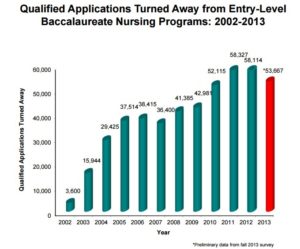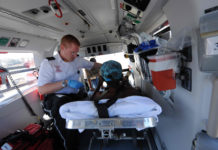Have you heard of the nursing shortage problem? It is common knowledge that nurses have unemployment issues so it is puzzling to hear that there is also a shortage of registered nurses in major countries.
So what is the problem with the current nursing workforce? Will this directly affect you and your job as a nurse? Read on and find out.
1. The baby boomers of our generation are aging, contributing 2 to 3 million additional patients each year.
The July 2001 report from the US Government Accountability Office cites that the demand for nurses will increase as baby boomers reach their 60s. This demand is expected to tax an already strained nursing system. The US, for example, is already experiencing a nursing shortage. It is reported that by 2025, the country will need 260,000 more RNs.
Also read: How Baby Boomers Will Impact The Nursing Shortage
2. The average age of the current nursing workforce is aging.
According to the 2013 survey conducted by the National Council of State Boards of Nursing, 55% of the nursing workforce is aged 50 or older. The batch of nurses that entered the nursing workforce in the 1970s is expected to retire between 2015 and 2022.
This means we can expect a massive wave of retirement among nurses in the next decades.
Also read: 10 Best Jobs for Older Nurses
3. The projected shortage is potentially double the shortage of nurses experienced in the mid 1960s.
The nursing shortage problem began during the 1930s. The beginning of the Great Depression caused high unemployment rates among nurses so many RNs fell out of the profession.
After the Great Depression, more healthcare facilities were built. The shortage of nurses became evident worldwide during the wartime period but in the 1960s, the shortage of nurses in the US was so big that the government took actions to resolve the problem. The 1964 Nurse Training Act was passed and significant funding to the nursing education increased the number of new RNs per year.
The nursing education is continuously supported nowadays since the 1964 Nurse Training Act was passed. However, it is a cause for concern that if the large batch of nurses that entered the profession in the 1960s will retire in the next years, supporting nursing education may not be as effective as before in resolving RN shortage.
For this reason, the anticipated shortage of nurses in the next years may have a higher impact in the economy if compared with the major RN shortage crisis experienced in the 1960s.
4. Registered Nursing is one of the top professions expected to have job growth until 2022.
This is unsurprising given the growing demand. In addition, the United States Department of Labor also cites that expected demand for nurses will reach up to 1 million by 2022. This projection factors in nurse replacements for retirees on top of the increasing number of patients each year.
Also read: Top 10 Highest Paying Jobs and Careers for Nurses
5. The shortage of nursing school faculty is restricting the growth of nursing enrollments.
According to reports, around 79,659 a qualified applicants from baccalaureate and graduate nursing programs were turned away by US nursing schools last 2012 due to insufficient faculty members, classrooms, clinical preceptors and clinical sites.
It is fast becoming a problem that aging faculty members are rarely being replaced by well-paid nurse practitioners and midwives. Salaries in teaching jobs are not as high when compared to salaries in independent nursing practice so finding suitable replacements for retired faculty members becomes a challenge.
6. Many nurses are driven to leave the profession due to insufficient staffing and improper nurse-patient ratio.
Job dissatisfaction among nurses is unavoidable if they are stressed out from taking care of too many patients on extended hours of duty. According to the March-April 2005 issue of the Nursing Economic$, 75% of nurses believe that the nursing workforce shortage will affect the quality of care provided to patients.
As the shortage of nurses sets in, more nurses will be forced to work overtime or take care of too many patients in a shift. Around 93% of nurses surveyed also believe that the shortage of nurses will likely drive them to leave the workforce.
7. Although the recession eased down the nursing shortage, it is not enough to address the problem in the future.
Because of the recession, unemployed individuals pursued nursing in hopes of catching better employment opportunities. The surge of nursing students during the recession is considered as a temporary solution but not the end to the shortage problem as stated by the Tri-Council for Nursing last July 2010.
Projected RN shortage in the year 2022 and beyond is still the same.
8. National vacancy rate of nursing in the US is 8.1%.
Last 2008, the American Health Care Association reported that more than 19,000 vacancies for nurses in long-term care settings are still left unfilled. There are even more than 116,000 RN vacancies in hospitals reported by the American Hospital Association last July 2007.
These statistics support the computed 8.1% national vacancy rate for nurses and this rate is pretty high compared to other professions.
9. To address RN shortage and prevent related problems in the future, annual nursing graduates should expand by 30%.
This translates to 30,000 additional nursing graduates each year to prevent shortage in the future as stated by The Council on Physician and Nurse Supply. This could be made possible by strengthening nursing schools in terms of adequate faculty members, clinical sites, clinical preceptors and many more.
In general, the nursing shortage crisis may lead to both good and bad outcomes for nurses. The shortage means nurses will have secured employment in the coming years but on the other hand, they are also at greater risk of suffering from imbalanced working conditions due to insufficient staffing. The shortage not only affects nurses but also patients, other healthcare workers, and administrators. The quality of care rendered to patients can be compromised if the problem will not be resolved satisfactorily.
SOURCES:
Economic News Release by the Bureau of Labor Statistics
The Recent Surge In Nurse Employment: Causes And Implications
Qualified Applications Turned Away from Entry-Level Baccaulaureate Nursing Programs: 2002-2013
Nursing Shortage by the American Association of Colleges of Nursing
“Where Did All the Nurse Go?”: Mid-Twentieth Century Nurse Shortages, Causes, Solutions, and Continuing Problems
Joint Statement from the Tri-Council for Nursing on Recent Registered Nurse Supply and Demand Projections by the Tri-Council of Nursing
About the Author: Je Abarra is a nurse by profession and a freelance writer by passion. She is working as a staff nurse in the pediatric ward of a private city hospital for more than two years. During her free time, she usually writes about her fascinations in health and nursing. She loves to provide tips and fun facts about nursing and healthy living.

























